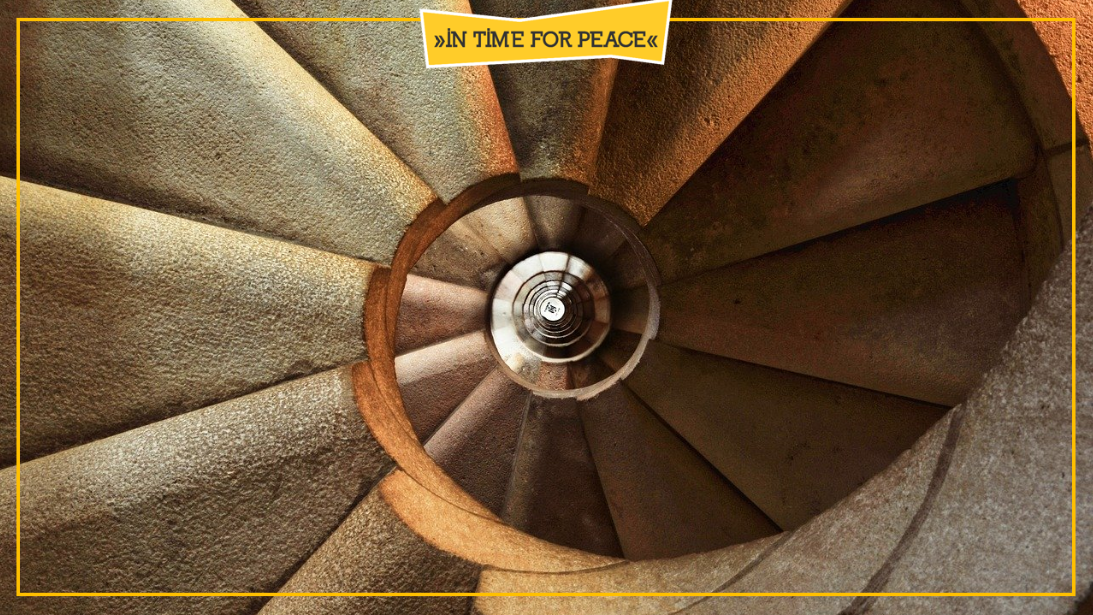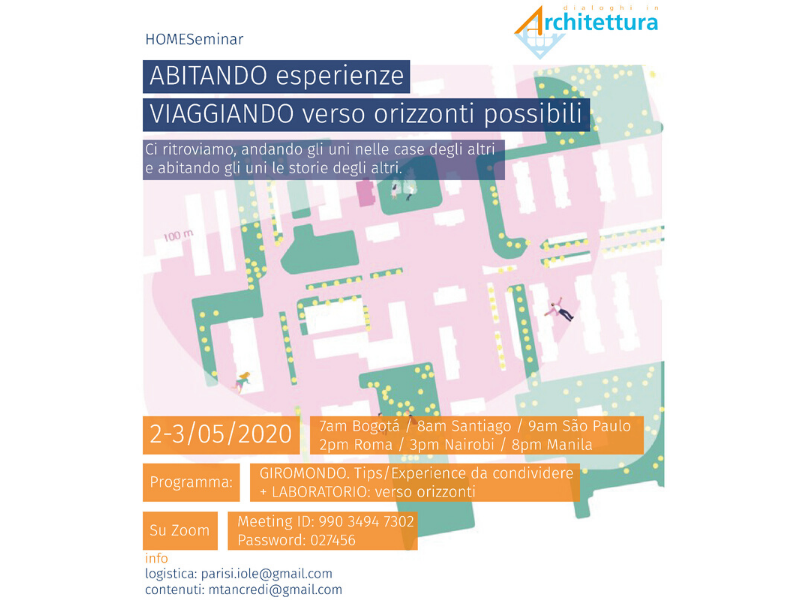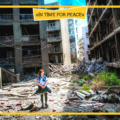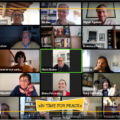
Watch
Now will we make things, together: Inhabiting and going, between good practices and solutions

Dialogue in Architecture: Following the cancellation of the Habitandando Workshop in Brazil as part of the now postponed World Congress of Architects “All the worlds. Just one world” in Rio de Janiero, a new initiative is underway to find “shared horizons”. It launches on May 2nd and 3rd, with the seminar “Inhabiting experiences, travelling towards possible horizons”.
Now will we make things, together:
Now, let’s do something together.

“How we will live together?” was the title of the 17th Venice Architecture Biennale. It concerned how we can give more importance to the quality of our relationships than the mere place we inhabit. It is not just about being next to one another, but about how we live together. It is a call to expand the horizons of our existence and not just performative functions. We are together, not alone; all in the same boat.
At a time when there was no suspicion of a health crisis, the architect Hashim Sarkis, curator of the 17th edition of the Biennale, addressed this vital question about the future. Now, it is more necessary than ever to think about how we can live together. It brings the question right into the present. It is not so much how we are going to live in the future. It is an urgent question of how we are going to live now.
We were, until recently, preparing for an international appointment in Rio de Janeiro, an ideal setting for a theme which is more topical than ever: “All worlds, one world”: The kaleidoscope that this city represents, together with the immense Brazil, awaited us with the thousands of architects summoned by the UIA (International Union of Architects) with the task of deepening, beyond the geographical globalization that the title of the event seems to suggest, a holistic vision on Diversity and Mixitè, Changes and Emergencies, Vulnerability and Inequalities, Transitions and Flux: four areas to deepen which we are now forced not just to think about, but to come up with concrete solutions in a radically different way than we would have previously thought. Diversity of situations with respect to the pandemic, between North and South, between rich and poor, children and the elderly and a diversity that in terms of social distance requires different solutions. Changes due to the Covid-19 emergency and the vulnerability of economic and health systems in different areas of the world that accelerate inequalities. The changing nature of current systems frozen by the distancing and new fluxes to be expected, in different ways of goods and people.
We cannot go to Rio and we cannot just think about general issues. Instead, we must concentrate on specific situations and needs. We must be able to look, even in the midst of a planetary crisis, at what is happening at home, alongside us. And we have to do this together, because we cannot think we can do it alone.
We believe and sustain that good ideas for the common good come from what each one of us can offer as lived experience, not only as abstract reflections. We must organize ourselves now in order to know how to carry this out. We are together, not to engage in architecture and plan new cities, but to put architecture and architects in dialogue with each other. And not only, since cities are “too important to be left only to architects”, as Giancarlo de Carlo used to say. Moreover, to engage in dialogue today is not easy: we are perhaps accustomed to everyone having their say in a chorus of voices, stories, experiences, ideas and reflections that, while beautiful, interesting, suggestive or prophetic, sometimes give us the impression of being in a supermarket where everyone sells their product or takes what they need.
After all, we have been influenced by Modernity which has accustomed us to divide thing up so as to better organize time and space, disciplines and functions: this is how we were trained and this is how our cities are: areas to stay and to work, to study and to take care of ourselves.
A virus has now reshuffled everything, making us go back to the starting point, resetting to zero times and spaces, functions, and safe places where we can take care of ourselves. We again find ourselves vulnerable, with spaces, which are off-limits, uncertain times, and functions, all which are reshuffled.
We are alone but also together. Like never before, never in such a “democratic” way, we are united by the same situation: rich and poor, South and North, East and West, non-believers and believers, Muslims and Christians, urban and rural dwellers.
Perhaps, we have not yet fully elaborated that this “being in the same boat” in so many people is not just a matter of standing next to each other. It is also necessary to agree, to understand which side to row on, to organize provisions, to define roles, to have a route and a port where to dock, together.
We wanted to go to Rio, to continue that wandering experience of Habitandando that had accustomed us to the good of learning enriched by reflecting on stories, experiences and good practices of the world in order to enrich their respective contexts and the public debate itself. We had been engaging in this form experience for ten years, in different places.
Unable to move, we now inhabit the narrow areas of isolation, continuing to occupy space and travel in a different way, opening the windows on the world of the many stories and experiences that are exploring new possibilities, bringing out from the emergency, new horizons. And since we can’t travel: it’s time to live the issues which concern us, recovering the etymological root of living -habere: “possessing” what happens around us. Health emergency, social distancing, economic difficulties, collapse of the flow of products, digital work, educational challenges, unsuitable homes, homes for those who don’t have them, relationships between real and digital… How many themes, stories and experiences with which every day we are flooded by twitter, articles, messages, TV channels.
In many places, we wonder how to deal with children who cannot go back to school while their parents resume work and if the school format we are used to still makes sense: somewhere, someone will be able to tell us if this is the theme that will provide us with the first examples and solutions.
For many cities, travelling is the greatest fear of reopening our cities: how can we avoid the crowds in the metro and the bus? By favouring the use of the car? On the other hand, how many people are already thinking about using bicycles?
Working at a distance in a digital way seems to favour the possibility not only of social distancing, but also of a balanced dispersion in the territory that could solve the growing imbalance between those who live in urban centres and those who live in peripheral regions. How many themes, how many possibilities, how many approaches there are. We could continue indefinitely. Moreover, who knows if there are not already concrete responses put in place by individuals, institutions, communities, professionals, companies, associations, which can be shared.
And who knows whether putting all these things together will open up possible paths and horizons.
“Let’s not go back to the world as before” Muhammad Yunus, the supporter of microcredit, suggested a few days ago, and we would not even want to venture into the science of futurology, risking prophecies about a situation that is so unstable.
We really need to believe in a grace of the present that is capable of directing our gaze and the necessary creativity starting from current situations.
What is certain is not so much that the world is changing but that, if we want, we can change it. Equally certain is that this pandemic is not an isolated episode: who knows how books (if they still exist) will tell the story of this first twenty years of the 21st century, which began with a tragic and frightening attack, continued with biblical migrations, climate change, environmental disasters, asymmetric wars. Maybe we can really change, not so much the world, but some tools to face it, seeing things from another point of view. Not having (too many) scientific certainties, we can recover the primacy of life over theory. We are all in the same boat not only as people but also as academic disciplines, in what we live and what we think. We are forced to sit together not at the tables of seminars and conferences, but in facing the real needs of schools and transport, work and health, the environment and social issues.
Until recently, globalization was celebrated, almost at the expense of the local, which suffered because of it, and which witnessed extreme peaks of what are well-known polarizations. We were worried about walls rising up and closed borders and now we are communicating far and wide with digital screens and greeting neighbours on our balconies. We had to measure levels of tolerance and now new levels of solidarity are overwhelming many barriers.
We will have to get used to looking at a world that we have always hoped would be more united, but beginning locally and from which we could form networks of experiences and stories to share. Perhaps we will now be able to build a good platform from the four corners of the globe to share themes and present a methodology of dialogue.
We need to share our experiences, as works in progress, communicating the dimensions of the problems, the challenges and the possible solutions.
This is the way to travel now; by listening, more than by our legs. Perhaps in this way we may be able to open up new horizons.
The future depends on what we do now. We can engage with the challenges and experiences where we are and allow our creativity to travel.How will we live together? It depends not just on how, but also on when. And the time is now.
Edited by the team of Dialogues in Architecture






